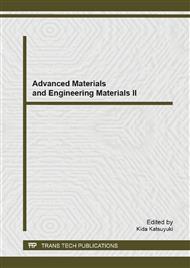[1]
W L Chou, C T Wang, W C Chang, et al. Journal of Hazardous Materials. 180 (2010) 217-224.
Google Scholar
[2]
S H Lin, C R Yang. Journal of Hazardous Materials B. 108(2004) 103-109.
Google Scholar
[3]
D S Lim, J W Ahn, H S Park, et al. Surface & Coatings Technology. 200 (2005)1751-1754.
Google Scholar
[4]
W Choi, S M Lee and R K Singh. Mat. Res. Soc. 671 (2001)M5. 1. 1- M5. 1. 6.
Google Scholar
[5]
J Perker. Solid State Technology. 47 (2004) 30-32.
Google Scholar
[6]
X L Song, N Jiang, Y K Li, et al. Materials Chemistry and Physics. 110 (2008) 128-135.
Google Scholar
[7]
S Oh, J Seok. Wear. 266 (2009) 839-849.
Google Scholar
[8]
Z F Zhang, L Yu, W L Liu, et al. Applied Surface Science. 256 (2010) 3856-3861.
Google Scholar
[9]
A I Y Tok, F Y C Boey, Z Dong, et al. Journal of Materials Processing Technology. 190 (2007) 217-222.
Google Scholar
[10]
J S Lee, J S Lee, S C Choi. Materials Letters. 59 (2005) 395-398.
Google Scholar
[11]
Y Ahn, J Yoon, C Baek, Y Kim, Wear. 257 (2004) 785-789.
Google Scholar
[12]
D S Bae, B Lim, B I Kim, et al. Materials Letters. 56 (2002) 610-613.
Google Scholar
[13]
X B Zhao, R W Long, Z G Chen, et al. Microelectronic Engineering. 87 (2010) 1716-1720.
Google Scholar
[14]
G L Li, T He, X M Li . Progress in Chemistry. 23 (2011) 1081-1089 (in Chinese).
Google Scholar
[15]
Y Chen, R W Long, Z G Chen. Materials Review. 24 (2010) 35-38 (in Chinese).
Google Scholar
[16]
Y Chen, R W Long, Z G Chen. The Chinese Journal of Nonferrous Metals. 20 (2010) 163-169 (in Chinese).
Google Scholar
[17]
R W Long, Y Chen, X B Zhao, et al. Tribology. 29(2009) 412-417 (in Chinese).
Google Scholar
[18]
K S Choi, R Vacassy, R K Singh, et al. Mat. Res. Soc. 671 (2001) M5. 8. 1-M5. 8. 10.
Google Scholar
[19]
M H Oh, J S Lee, R K Singh, et al. Colloids and Surfaces A. 355 (2010)1-6.
Google Scholar
[20]
X L Song, N Jiang, D F Liu, et al. Journal of the Chinese Ceramic Society. 36 (2008) 995-999.
Google Scholar
[21]
X L Song, D F Liu, Y M Zhanget al. Integrated Ferroelectrics. 129 (2011) 146-159.
Google Scholar
[22]
H Lei, F L Chu, B Q Xiao, et al. Microelectronic Engineering. 87 (2010)1747-1750.
Google Scholar
[23]
B Q Xiao, H Lei. Tribology. 28 (2008) 103-107 (in Chinese).
Google Scholar
[24]
S H Lee, Z Y Lu, S V Babu, J. Mater. Res. 17(2002) 2744-2749.
Google Scholar


